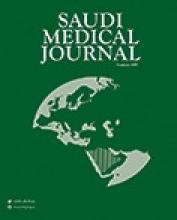SYSTEMATIC REVIEW
Diagnostic approaches to and management options for patulous eustachian tube
Khurayzi et al, review and summarize all evidence related to the diagnosis and management of patulous eustachian tube. Overall, 59 articles were retrieved and included in the analysis. Studies investigating treatments enrolled 1279 patients collectively, with follow-up duration varying from few days and up to 2 years. Eight studies reported medical treatments with intranasal saline instillation as the most frequently studied option. Other studies reported various surgical treatments varying from simple tympanostomy to invasive procedures targeting the orifice of the ET or the anatomical features surrounding it. In addition, 10 studies including 367 subjects investigated different diagnostic methods. Currently, there is a wide spectrum of diagnostic and therapeutic interventions with minimal clinical efficacy, a persistent lack of systematic guidelines, and several gaps in previous research endeavours.
see page 572
ORIGINAL ARTICLES
Enhancing the utilization of packed red blood cells stock in maternity hospitals
Bawazir & Dakkam, assess and enhance the efficiency of transfusion services in maternity hospitals from January to December 2016. A total of 1,200 BTRs were analyzed, comprising 659 before implementation of the corrective policy and 541 blood transfusion requests after implementation of the corrective policy. the C:T ratio of c-sections was nearly 7 times the American Association of Blood Banks recommended limit of 2.5. Most of the blood units (94%) were damaged due to repeated booking. After implementation, the cost-effectiveness of erythrocyte transfusion was greatly enhanced as all the ordered blood units were used and the C:T ratio was reduced to the ideal limit of one. Therefore, the policy enhances the cost-effectiveness of erythrocyte transfusion and laboratory testing, and saves on additional, unnecessary costs.
The utilization of erythrocyte units for maternity operations at Abha Maternity and Children’s Hospital (AMCH), Abha, Saudi Arabia in the pre-implementation period.
see page 628
Sail excision technique for overhanging thick ala in Saudi Arabia
Hudise et al, demonstrate that the sail excision technique is reliable, simple, and provides good patient satisfaction. Caring of alar soft tissue during rhinoplasty is important to correct overhanging alar to improve nasal appearance and patient satisfaction. Patients’ ages ranged from 18 to 37 years (mean, 26.34). The study included 22 men and 28 women. Mean preoperative and postoperative hinoplasty outcome evaluation (ROE) scores were 10.12 and 19.3 and visual analog scale (VAS) scores 5.14 and 7.94. P-values for preoperative and postoperative comparison of both ROE and VAS were statistically significant. The study aim to demonstrate the correction of overhanging alar with the vestibular triangular excision technique using preoperative and postoperative photographs.
Intra operative view showing the sail A) incision marking and B) sail triangular excision.
see page 635
CASE REPORT
Immunoglobulin G4-related spinal pachymeningitis
Alrashdi, presented a case of a 36-year-old Saudi male with a 4-month history of neck pain and progressive right arm and right leg weakness followed by a 1-month history of numbness over his right shoulder. He was found to had pachymeningeal thickening on a cervical magnetic resonance image (MRI) and elevated serum IgG4 levels. He was treated with glucocorticoids and rituximab, which led to a significantly positive radiological response.
A) Sagital and B) axial T1-Fat Sat postcontrast MR showing thickening extending from the dorsal aspect of clivus to T1 level with cord compression (arrow).
see page 652
- Copyright: © Saudi Medical Journal
This is an open-access article distributed under the terms of the Creative Commons Attribution-Noncommercial-Share Alike 3.0 Unported, which permits unrestricted use, distribution, and reproduction in any medium, provided the original work is properly cited.









